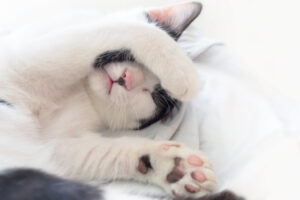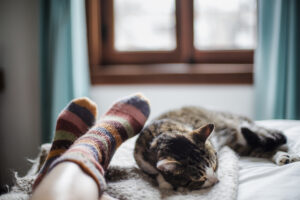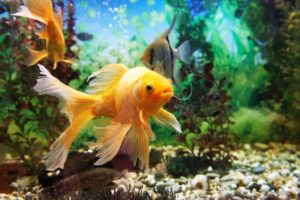The Connection Between Animal and Human Sleep
Do animals sleep? Absolutely! Like humans, nearly all animals need some form of rest or sleep. Most animals have a natural circadian rhythm or internal biological 24-hour clock that regulates sleep and wakefulness.
For humans, sleep is essential for overall health. Among other things, sleep allows humans to recharge, consolidate memories, and repair the body. Younger humans also need sleep to appropriately grow. Experts hypothesize that animals need sleep for similar purposes because, even though sleeping makes animals vulnerable, they do it anyway. The benefits of sleep are likely greater than the risks.
How Long Do Other Animals Sleep Compared to Humans?
The amount of sleep animals need varies greatly across species. Human newborns require up to 19 hours of sleep in a 24-hour period and adult humans require at least 7 hours of nightly sleep .
In comparison, many animals require much more sleep. The stereotype of a “lazy sloth” is founded in some truth—three-toed sloths need nearly 16 hours of sleep a day, and two-toed sloths need 16.4 hours . Other long sleepers include the little brown bat (19.9 hours), the North American opossum (19.4 hours), and the giant armadillo (18.1 hours).
However, some large land mammals require very little sleep. African elephants sleep an average of two hours a day , and cows and horses sleep between three and four hours a day .
In addition to sleeping for different lengths of time than humans, animals also divide their sleeping time differently. After young childhood, human sleep becomes monophasic or biphasic, typically taking place during one portion of a 24-hour period, possibly with a short nap during the day. Sleep in animals, however, is often polyphasic, or divided into several periods of time throughout a 24-hour period. For example, dogs tend to sleep between 9 and 14 hours each day but only sleep in 45-minute bouts . Cats sleep up to 13 hours a day, in 78 minute periods.

How Human Sleep Compares to the Sleep of Other Animals
It’s not only the required amount of sleep that varies among humans and other animals. Sleep cycles and processes that take place during sleep can also differ. These differences in sleep habits and needs are caused by many factors, including brain size, diet, body mass index (BMI), and social hierarchy . Predatory animals usually sleep in longer uninterrupted periods that are diurnal—primarily at night, like humans—or nocturnal—primarily during the daytime, like tigers.
REM Sleep in Humans and Animals
What happens while humans sleep? During sleep, our bodies cycle through four stages. Physical changes take place during each stage, such as decreased temperature and heart rate. Different types of brain activity also occur during each stage, with more activity taking place during the fourth stage, called rapid-eye movement (REM) sleep. In addition to the fluttering eyes behind eyelids, this sleep phase is also characterized by muscle twitching and waking-like electrical brain patterns (electroencephalogram or EEG ). Although humans can dream during any phase of sleep, they are most likely to during REM sleep.
Do all animals have REM sleep? Many terrestrial mammals, including primates, and some reptiles, birds, and aquatic invertebrates experience REM sleep. The amount of REM sleep varies widely depending on the species. Because elephants sleep so little, REM sleep doesn’t happen daily for them. In contrast, house cats can spend up to 8 hours a day in REM sleep.
Some animals, such as dolphins and whales, do not show typical behaviors associated with REM sleep. However, whales do exhibit some muscle jerking that might be representative of REM sleep.
The cycles of REM sleep vary across species, too. Humans experience REM sleep approximately every 90–120 minutes during sleep, while mice experience REM sleep every 10–15 minutes.
The Brain During Sleep in Humans and Animals
Animals obtain their sleep and rest in a multitude of ways. In contrast to humans, some animals only have one hemisphere of the brain sleep at a time. For example, in dolphins, it appears that only one half of the brain exhibits sleep characteristics while the other exhibits wakeful characteristics. This allows them to swim to the water’s surface to breathe in while sleeping.
Lack of Sleep in Humans and Animals
Without enough sleep, humans are susceptible to changes in mood, impaired memory, illness, and even death. These risks are true for many animals as well, such as rats. Rats that are sleep-deprived quickly lose weight and develop infections. After just a few weeks without proper sleep, rats die.
How Does Human Sleep Compare To Other Primate Sleep?
In a study of 30 types of primates, humans slept the least over a 24-hour period . One hypothesis explaining why humans sleep less than other primates is that in the past, humans faced increased pressures of survival, risks of being preyed upon , and benefits of social interaction. These experiences likely impacted current sleep practices. Today, humans have shorter, deeper sleep with more REM cycles than other primates. Human sleep is described as “more efficient” than the sleep of primates.
One clear commonality among primates is nest making, or, in the case of humans, bed making. Nest building is present across great ape species , though shapes, sizes, and locations of nests vary. Because of the prevalence of nest building, it is hypothesized that the last common ancestor between humans and other primates was a nest builder. While primate nests may have once been used primarily for feeding, they evolved into spaces of rest that promote better sleep. It’s also hypothesized that ground sleeping made human ancestors more vulnerable, so sleeping periods had to become shorter.
Sleep Disorders That Are Also Present In Animals
Comparative research of human sleep is commonly conducted on mice, rats, cats, and dogs. This research has shown that multiple species of animals can experience sleep disorders or mirror the effects of sleep disorders.
- Narcolepsy: Studies of both dogs and mice helped researchers identify a genetic mutation that causes narcolepsy in both animals . In the mutation, the neurons that produce hypocretin, which is responsible for regulating wakefulness, are destroyed. This finding has spurred research for the development of drugs that could mimic hypocretin and help patients with narcolepsy or other wakefulness disorders.
- Sleep Apnea: Mice have helped researchers identify how age, obesity, and unconscious muscle control affect sleep apnea. English bulldogs have many of the same sleep apnea characteristics as humans: snoring, disordered breathing, and frequent disruption during sleep. These dogs have been studied for pharmacological treatment of sleep apnea. Additionally, obese Yucatan minipigs have been used as a model for sleep apnea related to obesity.
- Insomnia: Rats introduced to a stressful environment exhibit characteristics similar to those associated with insomnia in humans. Rats that are given caffeine also model insomnia. However, it is difficult to find a natural animal model of insomnia because it is difficult to tell when an animal is not sleeping deliberately and when they are attempting to sleep, but unsuccessful.
- Restless Leg Syndrome (RLS): Both dopamine-deficient and iron-deficient mice can mimic the disrupted sleep behaviors of people with RLS. One challenge of researching RLS in animals is that the sensation of pain is typically patient-reported and therefore difficult to verify in animals.
Additionally, research on the circadian rhythm in primates may provide information that’s useful to humans. Increasing evidence shows that the circadian system develops neonatally before an infant is born. Primate infants have responded to light in the early stages of life. It is hypothesized that exposure to low light can help regulate the developing system. Because many sleep and overall health concerns stem from disordered circadian rhythms, this research can assist with future neonatal care for humans.

Still have questions? Ask our community!
Join our Sleep Care Community — a trusted hub of sleep health professionals, product specialists, and people just like you. Whether you need expert sleep advice for your insomnia or you’re searching for the perfect mattress, we’ve got you covered. Get personalized guidance from the experts who know sleep best.
References
13 Sources
-
Purves, D., Augustine, G. J., & Fitzpatrick, D. (Eds.). (2011). Why do humans and many other animals sleep? In Neuroscience (2nd ed.). Sinauer Associates.
https://www.ncbi.nlm.nih.gov/books/NBK11108/ -
Consensus Conference Panel, Watson, N. F., Badr, M. S., Belenky, G., Bliwise, D. L., Buxton, O. M., Buysse, D., Dinges, D. F., Gangwisch, J., Grandner, M. A., Kushida, C., Malhotra, R. K., Martin, J. L., Patel, S. R., Quan, S. F., Tasali, E., Non-Participating Observers, Twery, M., Croft, J. B., Maher, E., … Heald, J. L. (2015). Recommended amount of sleep for a healthy adult: A joint consensus statement of the American Academy of Sleep Medicine and Sleep Research Society. Journal of Clinical Sleep Medicine, 11(6), 591–592.
https://pubmed.ncbi.nlm.nih.gov/25979105/ -
Campbell, S. S., & Tobler, I. (1984). Animal sleep: A review of sleep duration across phylogeny. Neuroscience & Biobehavioral Reviews, 8(3), 269–300.
https://pubmed.ncbi.nlm.nih.gov/6504414/ -
Gravett, N., Bhagwandin, A., Sutcliffe, R., Landen, K., Chase, M. J., Lyamin, O. I., Siegel, J. M., & Manger, P. R. (2017). Inactivity/sleep in two wild free-roaming African elephant matriarchs – Does large body size make elephants the shortest mammalian sleepers? PLoS One, 12(3), e0171903.
https://pubmed.ncbi.nlm.nih.gov/28249035/ -
Aserinsky, E. (1999). Eyelid condition at birth: Relationship to adult mammalian sleep-waking patterns, in B.N. Mallick and S. Inoue (Eds.), Rapid Eye Movement Sleep, , New Delhi: Narosa Publishing., Retrieved February 9, 2021, from
https://books.google.com/books?id=r9k4CkerWLIC&pg=PA1&lpg=PA1#v=onepage&q&f=false -
Toth, L. A., Bhargava, P. (2013). Animal models of sleep disorders. Comparative Medicine, 63(2), 91-104.
https://pubmed.ncbi.nlm.nih.gov/23582416/ -
Keene, A. C., & Duboue, E. R. (2018). The origins and evolution of sleep. The Journal of Experimental Biology, 12;221(Pt 11), jeb159533.
https://www.ncbi.nlm.nih.gov/pmc/articles/PMC6515771/ -
Peever, J., & Fuller, P. M. (2017). The biology of REM sleep. Current Biology, 27(22), R1237-R1248.
https://pubmed.ncbi.nlm.nih.gov/29161567/ -
Nunn, C. L., & Samson, D. R. (2018). Sleep in a comparative context: Investigating how human sleep differs from sleep in other primates. American Journal of Physical Anthropology. 166(3), 601-612.
https://pubmed.ncbi.nlm.nih.gov/29446072/ -
Samson, D. R., & Nunn, C. L. (2015). Sleep intensity and the evolution of human cognition. Evolutionary Anthropology, 24(6), 225-37.
https://pubmed.ncbi.nlm.nih.gov/26662946/ -
Fruth, B., Tagg, N., & Stewart, F. (2018). Sleep and nesting behavior in primates: A review. American Journal of Physical Anthropology, 166(3), 499-509.
https://pubmed.ncbi.nlm.nih.gov/29989164/ -
Mignot, E. J. M. (2014). History of narcolepsy at Stanford University. Immunologic Research. 58(2-3), 315-39.
https://pubmed.ncbi.nlm.nih.gov/24825774/ -
Rivkees, S. A. (2007). The development of circadian rhythms: From animals to humans. Sleep Medicine Clinics, 2(3), 331-341.
https://pubmed.ncbi.nlm.nih.gov/19623268/








